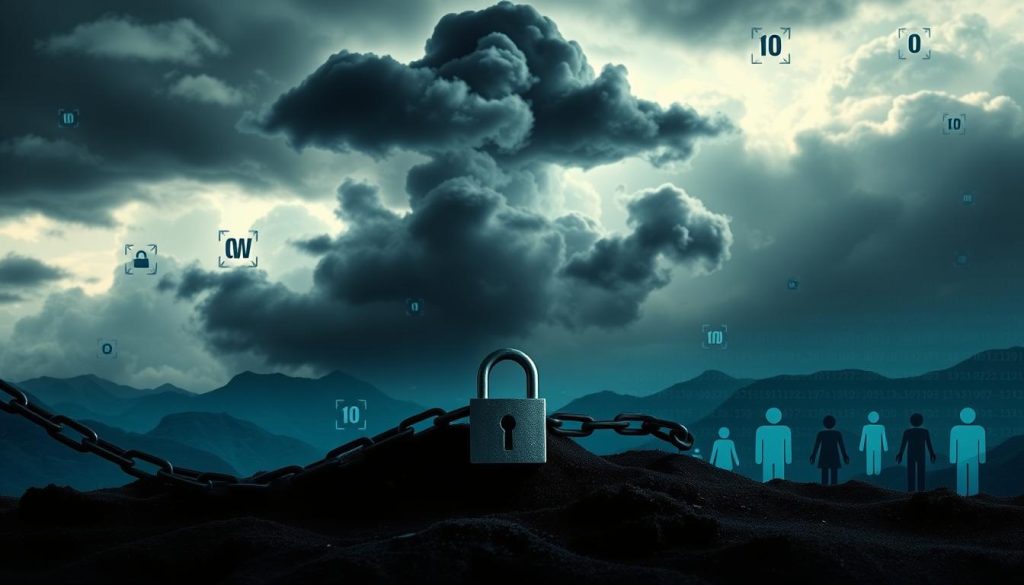Cloud computing is becoming more popular, but knowing its downsides is important. It offers benefits like scalability and cost savings. Yet, it also has challenges that users should think about before jumping in. This article will explore the main concerns and disadvantages of cloud computing. It aims to help you make smart choices about your technology.
Key Takeaways
- Cloud computing can pose significant security and privacy risks, with vulnerabilities to cyber threats and concerns over data ownership and control.
- Vendor lock-in and dependency on cloud service providers can limit your flexibility and autonomy, potentially leading to costly switching or exit challenges.
- Limited control and customization options in cloud environments can hinder your ability to tailor solutions to your specific needs, resulting in inflexibility.
- Downtime and performance issues with cloud services can disrupt your operations and productivity, potentially leading to financial and reputational consequences.
- Compliance and regulatory challenges in the cloud can add complexity and risk, requiring careful navigation of industry standards and legal requirements.
- Cost uncertainties and hidden fees associated with cloud computing can lead to unexpected expenses and budgetary challenges.
What is Cloud Computing?
Cloud computing is a game-changer in how we use computing resources. It lets us access and use computing services like storage and software over the internet. This way, we don’t need to rely on our own devices or servers.
Understanding the Cloud Ecosystem
The cloud world includes many service providers and applications. These work together to make it easy and flexible for users to get what they need. Whether it’s big tech companies or specialized cloud services, there’s a lot to choose from.
Benefits of Cloud Computing
- Scalability: Cloud computing lets users adjust their resources as needed. This means they always have what they need.
- Cost Savings: By using cloud services, users save money compared to having their own servers.
- Improved Accessibility: Cloud computing makes it easy to access data and apps from anywhere. This boosts flexibility and teamwork.
- Automatic Updates: Cloud providers take care of updates and maintenance. This means users always have the latest and safest versions.
Cloud computing has many benefits, but it also has downsides and challenges. Knowing these can help people and businesses make smart choices about using the cloud.

Disadvantages of Cloud Computing: An Overview
Cloud computing has many benefits, but it also has downsides. These include security and privacy issues, vendor lock-in, and limited control. Other concerns are performance problems, compliance challenges, and cost uncertainties.
Data security and privacy are major concerns with cloud computing. Even though cloud providers protect your data, breaches can still happen. This is especially risky for industries with strict rules.
Vendor lock-in is another big issue. It means you’re stuck with one cloud service provider. Switching to another can be expensive and take a lot of time, limiting your options.
Cloud computing often lacks control and customization. You have to rely on the provider’s setup, which might not fit your needs perfectly. This can make it hard to improve your business processes.
Performance issues and downtime are also concerns. Cloud services can slow down or go offline, affecting your work. It’s important to ensure they work reliably.
Compliance and regulatory challenges are another issue. Cloud providers might not always meet your industry’s standards. Dealing with these rules can be complex and take a lot of time.
Lastly, there are cost uncertainties and hidden fees. Cloud computing can save money, but unexpected charges can surprise you. This can lead to budget problems.
Knowing these downsides can help you decide if cloud computing is right for you. It’s important to weigh the pros and cons carefully.

Data Security and Privacy Risks
One big problem with cloud computing is the risk to data security and privacy. Cloud providers handle sensitive data, making it a target for cyber threats. This includes data breaches, hacking, and unauthorized access. Your data might be more at risk than if it were stored on your own servers.
Also Read Benefits of Cloud Computing for Businesses
Vulnerabilities and Cyber Threats
The cloud computing security risks come from many places. These include:
- Weak access controls and authentication measures
- Inadequate data encryption and protection protocols
- Cloud vulnerability to cyber attacks such as distributed denial-of-service (DDoS) attacks
- Insider threats from malicious cloud service provider employees
- Lack of visibility and control over data storage and processing
These cloud data security concerns can lead to big problems. They can expose sensitive information, financial data, and intellectual property. This can cause data breaches, identity theft, and harm a business’s reputation.
| Security Concern | Potential Impact |
|---|---|
| Data Breaches | Exposure of sensitive information, financial data, and intellectual property |
| Unauthorized Access | Theft of data, intellectual property, and financial assets |
| Malware Attacks | Disruption of operations, data corruption, and financial losses |
| Compliance Violations | Regulatory fines, legal liabilities, and reputational damage |
To deal with these cloud privacy issues and security risks, organizations must be careful. They should check the security and data protection of their cloud providers. They also need to use strong access controls, encryption, and data backup strategies.

Vendor Lock-In and Dependency Concerns
Choosing a cloud service provider makes you rely heavily on their platform. This can cause cloud vendor lock-in, making it hard to switch to another provider. It limits your flexibility and makes it tough to use new technologies or services.
The reliance on cloud providers poses big challenges for businesses. As you get more tied to a specific cloud, switching becomes harder. This makes it difficult to meet changing business needs or use new cloud technologies.
This cloud provider dependency makes you vulnerable. Your operations and data are closely tied to one vendor. If that vendor has outages, service disruptions, or changes its pricing, it can hurt your business a lot.
| Concern | Impact |
|---|---|
| Vendor Lock-In | Limits flexibility and ability to take advantage of new technologies |
| Reliance on Cloud Providers | Increases difficulties in switching cloud services |
| Cloud Provider Dependency | Leaves businesses vulnerable to provider’s actions and changes |
To deal with these issues, it’s key to carefully pick cloud providers. Understand their ecosystem and the risks of lock-in. Also, keep your cloud strategy flexible. Looking into multi-cloud or hybrid cloud options can reduce your reliance on one vendor. This gives you more ways to manage your cloud infrastructure.
Limited Control and Customization
Cloud computing has its downsides, like limited control and customization options. When you use a cloud service, you might not have full control over the setup, software, and security. This makes it hard to adjust the cloud to fit your exact needs.
Also, some cloud services are not very flexible. This means you can’t easily change things as your needs change. The lack of control in cloud computing and limited customization options can be a big problem for those who need more control over their tech.
Inflexibility and Lack of Tailoring
Cloud computing also has issues with cloud service inflexibility and inability to tailor cloud solutions to your needs. Many cloud providers offer standard services that might not match your specific needs or preferences.
- Lack of flexibility to make changes or modifications to the cloud infrastructure
- Difficulty in integrating cloud services with your existing on-premise systems or workflows
- Limitations in customizing the user interface, features, or functionality of the cloud platform
This lack of tailoring can be a big problem for businesses or individuals who need a cloud solution that’s more personalized and adaptable.
“The inability to fully customize cloud solutions can be a significant limitation for businesses with unique requirements or specialized workflows.” ( Disadvantages of Cloud Computing )
Downtime and Performance Issues
Cloud computing has its downsides, like downtime and performance problems. Cloud computing downtime problems can really mess up your work. They can block your access to important data and apps, making your business weak.
Also, the need for a steady internet and cloud-based application latency can cause trouble. This can make your work slow and full of interruptions. It can hurt your productivity and how users feel about your service. ( Disadvantages of Cloud Computing )
| Issue | Impact | Mitigation Strategies |
|---|---|---|
| Downtime | Disruption to operations, loss of access to critical data and applications | Implement redundancy and failover mechanisms Maintain local backups of critical data Diversify cloud providers to reduce single points of failure |
| Performance Issues | Slow response times, decreased productivity, poor user experience | Optimize network connectivity and bandwidth Leverage edge computing and content delivery networks Monitor and optimize cloud resource utilization |
To tackle these problems, companies need strong plans to keep their cloud services running smoothly. By fixing these issues, businesses can make the most of cloud computing. This way, they can avoid big problems in their work.
“Cloud computing is a game-changer, but it’s not a panacea. Businesses must be proactive in managing the potential downsides to ensure a seamless and reliable cloud experience.”
Compliance and Regulatory Challenges
Cloud computing offers convenience and cost savings, but it also brings compliance and regulatory challenges. Your industry or location may have specific data protection rules, standards, and security measures. These must be followed carefully.
Meeting these compliance needs can be tough. You might find it hard to show you follow the rules to auditors or regulators. This could lead to legal and financial problems for your business.
Navigating Industry Standards
The cloud computing world has set up many standards and best practices. These address common compliance issues. Some key standards include:
- ISO 27001/27002 – International standards for information security management
- NIST SP 800-171 – Security requirements for non-federal information systems
- PCI DSS – Payment Card Industry Data Security Standard
- HIPAA – Health Insurance Portability and Accountability Act
Understanding and following these standards is complex and time-consuming. It requires careful planning, detailed documentation, and teamwork with your cloud providers. This ensures you handle compliance issues well.
| Industry Standard | Key Focus Areas |
|---|---|
| ISO 27001/27002 | Information security management, risk assessment, and control implementation |
| NIST SP 800-171 | Regulatory requirements for cloud services, data protection, and access control |
| PCI DSS | Secure handling of payment card data and transaction processing |
| HIPAA | Industry standards for cloud data management, privacy, and security for healthcare data |
By knowing and following these standards, you can overcome cloud computing’s compliance hurdles. This ensures you meet the regulatory requirements for cloud services.
Cost Uncertainties and Hidden Fees
Cloud computing can save money, but it also has hidden costs of cloud computing. Providers often use unpredictable cloud service pricing models. This makes it hard to guess and control your cloud spending each month or year.
Also, there might be unexpected fees in cloud adoption. These can include charges for data egress, backup, or special features. These extra fees can eat away at the expected savings, making it key for businesses to know all costs before moving to the cloud.
- Unpredictable usage-based pricing models
- Charges for data egress, backup, and additional features
- Difficulty in forecasting and managing cloud costs
- Unexpected fees that can undermine cost savings
| Cost Factor | Potential Hidden Costs |
|---|---|
| Data Egress | Fees for transferring data out of the cloud |
| Backup and Archiving | Charges for data backup and long-term storage |
| Upscaling and Downscaling | Fees for adjusting computing resources |
| Advanced Features | Costs for premium or specialized services |
Knowing the hidden costs of cloud computing and managing cloud cost management challenges well can help. Businesses can then make better choices. This ensures their cloud move fits their budget and financial goals.
Disadvantages of Cloud Computing
Cloud computing has many benefits, but it also has downsides. Organizations need to think about these before deciding to use it. The main issues include:
- Data Security and Privacy Risks: Keeping sensitive data on remote servers can lead to breaches and unauthorized access. It also makes following industry rules hard.
- Vendor Lock-In and Dependency: Using one cloud provider can make switching hard and expensive later on.
- Limited Control and Customization: Businesses might not have much control over their setup. They also can’t always tailor cloud services to fit their needs.
- Downtime and Performance Issues: Cloud problems can cause service outages. This hurts business operations and customer satisfaction.
- Compliance and Regulatory Challenges: Cloud services can make following industry rules tricky, especially for strict industries.
- Cost Uncertainties and Hidden Fees: Cloud pricing can be tricky. Unexpected costs or hidden fees can make budgeting hard.
These cloud computing downsides are important to consider when thinking about using cloud services. Knowing the risks helps make better choices and plan for challenges.
| Disadvantage | Description |
|---|---|
| Data Security and Privacy Risks | Storing sensitive data on remote servers raises concerns about data breaches, unauthorized access, and compliance with industry regulations. |
| Vendor Lock-In and Dependency | Relying on a single cloud provider can lead to vendor lock-in, making it difficult and costly to switch platforms in the future. |
| Limited Control and Customization | Businesses may have limited control over their infrastructure and limited ability to customize cloud-based solutions to their specific needs. |
| Downtime and Performance Issues | Cloud outages and network latency can lead to service disruptions, negatively impacting business operations and customer experiences. |
| Compliance and Regulatory Challenges | Navigating industry-specific compliance requirements can be complex when using cloud-based services, especially for highly regulated industries. |
| Cost Uncertainties and Hidden Fees | Cloud pricing models can be complex, and unexpected costs or hidden fees may arise, making it difficult to accurately forecast and manage cloud-related expenses. |
By knowing these cloud computing downsides, organizations can make better choices. They can also plan to avoid risks.
“The cloud is not a silver bullet, and it comes with its own set of challenges that organizations must be aware of and prepared to address.”
Conclusion of Disadvantages of Cloud Computing
Cloud computing has many benefits, but it’s important to know its downsides before using it. You need to think about security, control, performance, compliance, and costs. This helps you decide if cloud services are right for you.
There are risks like data breaches and vendor lock-in. You might also face limited customization and unexpected costs. It’s crucial to weigh these concerns carefully.
Choosing cloud computing should be a well-informed decision. Knowing its strengths and weaknesses is key. By understanding the risks, you can use the cloud safely and effectively. With careful planning, you can make the best choice for your needs.
FAQ ( Disadvantages of Cloud Computing )
What are the main disadvantages of cloud computing?
Cloud computing has several downsides. These include risks to your data security and privacy. It also means you might rely too much on one vendor. You could face issues with control, downtime, and performance. There are also challenges with following rules and uncertainty about costs.
What are the security and privacy risks associated with cloud computing?
Cloud computing can be risky for your data. Since your data is managed by someone else, it’s more vulnerable. This means you could face data breaches or unauthorized access.
How can vendor lock-in be a concern with cloud computing?
Choosing a cloud service provider can make you dependent on them. This is known as vendor lock-in. It can be hard or expensive to switch to another provider, limiting your options.
What are the limitations of control and customization in cloud computing?
Cloud computing gives you less control over your setup. You can’t always customize it to fit your needs. This can make it hard to tailor the cloud to your specific requirements.
What are the potential issues with downtime and performance in cloud computing?
Cloud services can have downtime and performance issues. These problems can affect your work and access to important data. Issues with the cloud provider’s infrastructure or network latency can cause these problems.
How can compliance and regulatory challenges affect cloud computing adoption?
Cloud computing can be tricky to follow rules and regulations. Cloud providers must meet many data protection standards. This can be hard to manage and prove to auditors or regulators.
What are the cost uncertainties and hidden fees associated with cloud computing?
Cloud computing can save money, but it also has risks. Costs can be unpredictable, and there might be hidden fees. These can include charges for data transfer, backups, or special features, adding to your expenses.




